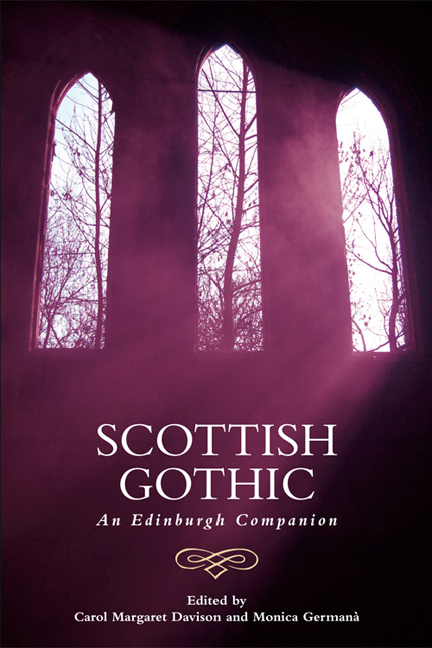Book contents
- Frontmatter
- Contents
- Acknowledgements
- 1 Borderlands of Identity and the Aesthetics of Disjuncture: An Introduction to Scottish Gothic
- 2 ‘The Celtic Century’ and the Genesis of Scottish Gothic
- 3 The Politics and Poetics of the ‘Scottish Gothic’ from Ossian to Otranto and Beyond
- 4 Robert Burns and the Scottish Bawdy Politic
- 5 Scottish Gothic Drama
- 6 Scottish Gothic Poetry
- 7 Calvinist and Covenanter Gothic
- 8 Gothic Scott
- 9 Gothic Hogg
- 10 ‘The Singular Wrought Out into the Strange and Mystical’: Blackwood's Edinburgh Magazine and the Transformation of Terror
- 11 Gothic Stevenson
- 12 J. M. Barrie's Gothic: Ghosts, Fairy Tales and Lost Children
- 13 The ‘nouveau frisson’: Muriel Spark's Gothic Fiction
- 14 Scottish Gothic and the Moving Image: A Tale of Two Traditions
- 15 New Frankensteins; or, the Body Politic
- 16 Queer Scottish Gothic
- 17 Authorship, ‘Ghost-filled’ Islands and the Haunting Feminine: Contemporary Scottish Female Gothic
- Notes on Contributors
- Index
5 - Scottish Gothic Drama
Published online by Cambridge University Press: 20 December 2017
- Frontmatter
- Contents
- Acknowledgements
- 1 Borderlands of Identity and the Aesthetics of Disjuncture: An Introduction to Scottish Gothic
- 2 ‘The Celtic Century’ and the Genesis of Scottish Gothic
- 3 The Politics and Poetics of the ‘Scottish Gothic’ from Ossian to Otranto and Beyond
- 4 Robert Burns and the Scottish Bawdy Politic
- 5 Scottish Gothic Drama
- 6 Scottish Gothic Poetry
- 7 Calvinist and Covenanter Gothic
- 8 Gothic Scott
- 9 Gothic Hogg
- 10 ‘The Singular Wrought Out into the Strange and Mystical’: Blackwood's Edinburgh Magazine and the Transformation of Terror
- 11 Gothic Stevenson
- 12 J. M. Barrie's Gothic: Ghosts, Fairy Tales and Lost Children
- 13 The ‘nouveau frisson’: Muriel Spark's Gothic Fiction
- 14 Scottish Gothic and the Moving Image: A Tale of Two Traditions
- 15 New Frankensteins; or, the Body Politic
- 16 Queer Scottish Gothic
- 17 Authorship, ‘Ghost-filled’ Islands and the Haunting Feminine: Contemporary Scottish Female Gothic
- Notes on Contributors
- Index
Summary
Scottish theatre, from the mid-eighteenth century onwards, has been characterised by a distinctive performance culture that values anti-illusionist techniques, breaking the fourth wall, music and song, strongly physical acting styles and striking visual effects. These were accepted traits of the Georgian theatre as a whole; however, they endured in Scotland through the music hall and pantomime traditions, when late nineteenth-century Western theatre was focused on realism/naturalism. Their importance to the search for a distinctive Scottish Gothic Drama lies in the way that the conditions of the Scottish theatre during the Gothic Revival valued these skills and effects. That theatre was heavily constricted in what it could play by censorship from London and writers were cautious in their approach to ‘national’ topics. At the same time a good deal of work portraying Scotland as an inherently Gothic setting was imported onto Scottish stages. The result, for much of the period, was a fractured ‘Scottish Gothic’ stage presence, with imported works easily outnumbering native pieces, whilst Scottish writers experimented with Gothic tropes and the ‘industry’ playwrights, actors and managers, some of them Scots, trod a fine pragmatic line between audience approval and the law. This chapter seeks to separate the multiple strands of Scottish Gothic Drama and uncover the enduring legacy of the Gothic Revival theatre in Scotland. It also explains how contemporary Scottish playwrights and theatre-makers have embraced that ‘Gothic’ heritage in ways best explained through theories of site-specific performance.
In his pioneering work English Melodrama, Michael Booth claimed that ‘Scottish Gothic, created mainly by Scott, simply transplanted the usual characters and situations of melodrama … [adding] a dash of nationalism, to vaguely historical and strongly romantic Scottish settings’ (1965: 77–8). His later Prefaces to English Nineteenth-Century Theatre emphasised the importance of the ‘particular relationship between a play and the theatre that first performed it’ (1980: viii). This point, if pursued, would have revealed that what had appeared a homogenous group of ‘Scottish Gothic’ included many works from the ‘Covent Garden Caledonian’ (CGC) style of theatre, and others from the Scottish National Drama. Covent Garden Caledonian gave a fashionable tartan dressing to pieces originating outside Scotland, such as Charles Farley's 1803 ballet Red Roy; or Oswyn and Helen (Bell 1998).
- Type
- Chapter
- Information
- Scottish GothicAn Edinburgh Companion, pp. 59 - 74Publisher: Edinburgh University PressPrint publication year: 2017

